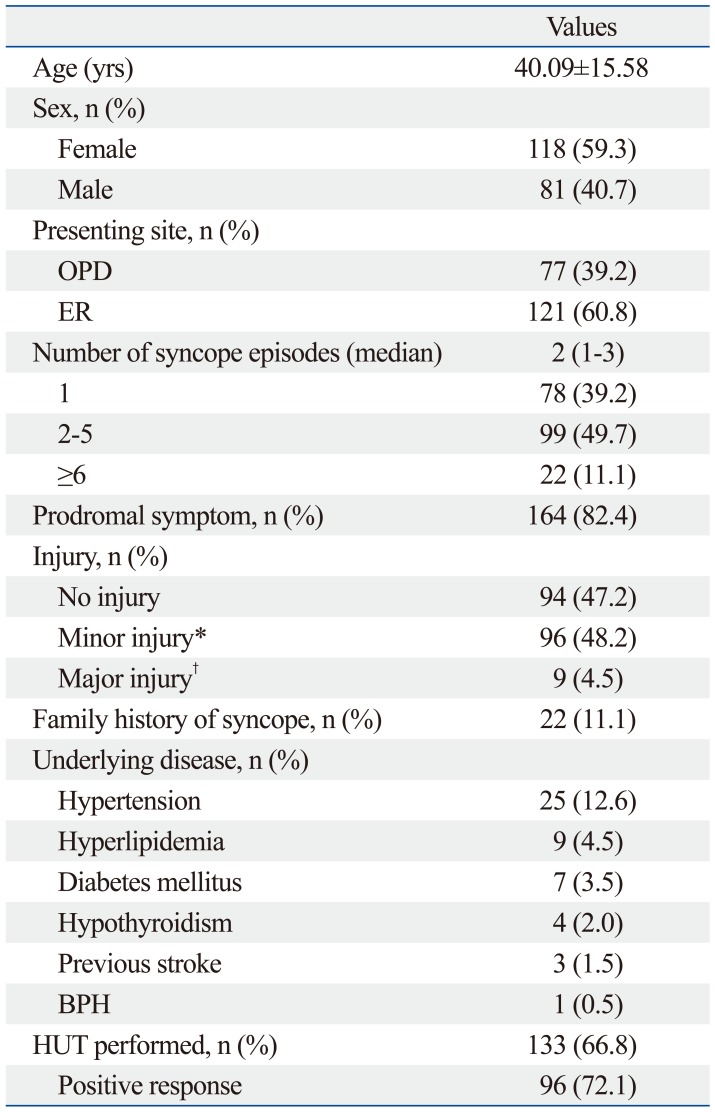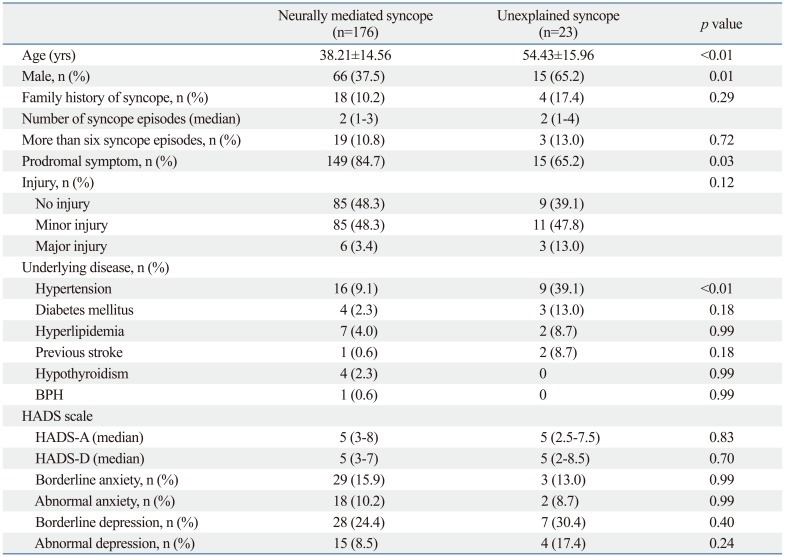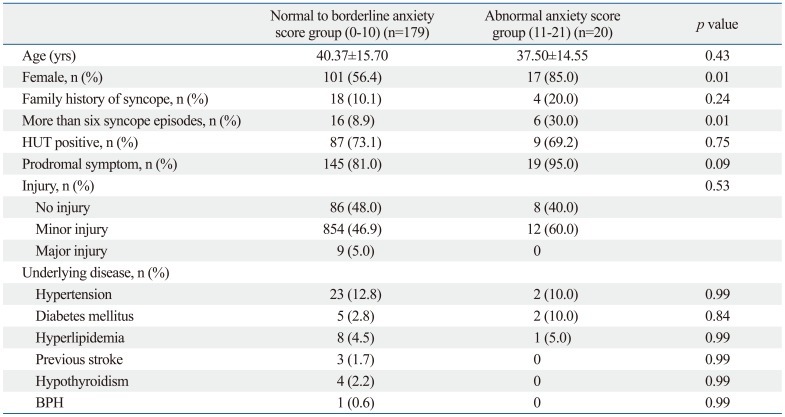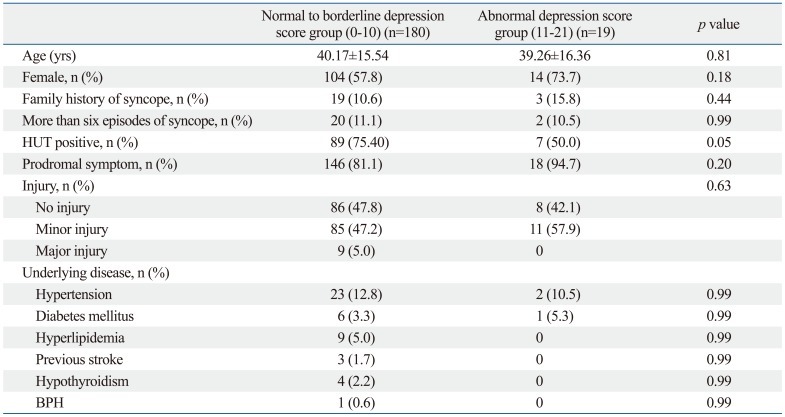Abstract
Purpose
Several studies have demonstrated that psychiatric disorders such as anxiety, depression and panic attack are associated with syncope, especially vasovagal and unexplained syncope (US). The aim of this study was to compare the prevalence of anxiety and depression between patients with neurally mediated syncope (NMS) and US and to investigate the clinical factors associated with anxiety and depression.
Materials and Methods
Between January 2009 and March 2010, 383 patients with syncopal episodes completed a Hospital Anxiety and Depression Scale questionnaire to assess symptoms of anxiety and depression. Inclusion criteria were NMS and US. Exclusion criteria were cardiac syncope, orthostatic hypotension and other disorders mimicking syncope. After exclusion, 199 patients were included.
Results
There were 176 (88.4%) NMS patients and 23 (11.6%) US patients. The prevalence of abnormal anxiety and depression were not significantly different between the NMS and US groups (10.2% vs. 8.7%, p=0.99; 8.5% vs. 17.4%, p=0.24). Clinical factors associated with anxiety were female gender (p=0.01) and six or more recurrent syncopal episodes (p=0.01) by univariate analysis. The only factor associated with abnormal anxiety score (OR=20.26, 95% CI: 1.4-291.6, p=0.01) was more than six recurrent syncopal episodes, while a positive head-up tilt table testing response was inversely associated with abnormal depression score (OR=0.28, CI: 0.08-0.97, p=0.04) in the multiple logistic regression analysis.
Conclusion
Anxiety was associated with frequent syncopal episodes. Thus, anxiety might be considered in the management of syncope patients.
Keywords: Anxiety, depression, syncope
INTRODUCTION
Syncope is defined as a transient loss of consciousness and postural tone caused by global cerebral hypoperfusion. Recovery is spontaneous, complete, and rapid. The incidence of syncope ranges from 3% to 35% over a person's lifetime.1,2 However, a substantial number of patients experience recurrent syncopal episodes. Recurrent syncope can cause functional impairment in addition to physical and psychiatric impairment.3 Recurrent syncope may also increase the incidence of anxiety or mood disorders.4 Several studies have demonstrated that psychiatric disorders are especially associated with recurrent vasovagal syncope (VVS) or unexplained syncope (US).4-8 The prevalence of psychiatric disorders in patients with VVS or US is reported to be higher than average and these psychiatric disorders affect the response to treatment for syncope as well as predicting syncopal recurrence in US8,9 and VVS.4,6,10 However, little evidence is available for evaluating the prevalence of anxiety and depression between neurally-mediated syncope (NMS) and US, or pursuing related clinical factors in Korean patients with syncope.
The aim of this study was to compare the prevalence of anxiety and depression between people with NMS and US and to investigate the clinical factors associated with anxiety and depression in affected patients.
MATERIALS AND METHODS
Study population
Three hundred and eighty-three consecutive patients with syncopal episodes who visited the emergency room or outpatient department of Samsung Medical Center, Seoul, Korea were prospectively enrolled between January 2009 and March 2010. Inclusion criteria were NMS syncope (including VVS and situational syncope) and US. Exclusion criteria were cardiac syncope or orthostatic hypotension; another disease causing transient unconsciousness such as cerebrovascular disease including acute cerebral infarction and transient ischemic attacks; seizure; hypoglycemia; drug intoxication; benign paroxysmal positional vertigo; and hyperventilation syndrome. Among the 383 enrolled patients, 86 were excluded because of cardiac syncope (23 patients), orthostatic hypotension (36 patients), lack of a complete evaluation (24 patients), or lack of true syncope (3 patients). In addition, 98 patients declined participation in the questionnaire survey. Therefore, 199 patients were included in this study. Informed consent was obtained from each patient before participation. The study was approved by the regional ethics committee in medical research for the evaluation of syncope.
Evaluation of syncope
All patients underwent detailed medical history documentation and a complete physical examination. An electrocardiogram, echocardiography, head-up tilt table testing (HUT), and 24-hour ambulatory holter monitoring were performed when clinically indicated. According to ESC guidelines,11 NMS refers to conditions in which an abnormal cardiovascular reflex occurs in response to a trigger, resulting in syncope. NMS is classified into VVS, situational syncope, carotid sinus syncope, and atypical forms of syncope, based on the trigger. VVS is the most common cause of NMS. Clinical features indicating NMS for this study were absence of heart disease, long history of recurrent syncope, occurrence of syncope after sudden unexpected unpleasant sight, sound, smell or pain, prolonged standing or crowding, hot places, or presence of prodromal symptoms such as nausea or vomiting associated with syncope. After cardiac syncope and orthostatic hypotension were excluded by a complete work up, NMS was diagnosed based these clinical features. Situational syncope was diagnosed if syncope occurred during or immediately after specific triggers such as coughing, sneezing, gastrointestinal stimulation, micturition. Clinical features indicating US for this study were syncope without apparent trigger and/or lack of prodromal symptoms, irrespective of HUT results. When a thorough medical history did not suggest NMS, US was diagnosed if the exact mechanism of syncope was still unknown or uncertain at the end of a complete work-up. Syncope-related injury was defined as any physical trauma secondary to syncope that was sufficiently clinically relevant to be mentioned in the patient's medical records. Syncope related to minor injury was defined as swelling, ecchymosis or bruising, abrasion or laceration, and hematoma or minor bleeding. Syncope-related major injury was defined as a major bone segment fracture such as of the skull, causing intracranial hemorrhage and tooth subluxation. Prodromal symptoms were defined as symptoms of autonomic activation that occurred before unconsciousness such as sweating and pallor; cardiopulmonary symptoms such as dyspnea, palpitation or chest discomfort; gastrointestinal symptoms such as indigestion, nausea, vomiting, sensation of defecation, and abdominal pain or discomfort; and cerebral hypoperfusion symptoms such as dizziness, weakness, extreme fatigue and vertigo.
Head-up tilt test protocol
HUT was performed in patients who fasted for 4 hours in a quiet room. After 10 min of supine rest, the patient was tilted upright to 70 degrees for 30 minutes with a footboard used for weight bearing. Blood pressure and electrocardiographic rhythm were monitored at baseline and during HUT. If syncope or presyncope were not induced, an isoproterenol infusion was started at a rate of 1 µg/min without returning the patient to the supine position; infusion rate was increased every 3 minutes to achieve an increase of 20% above the baseline heart rate for 15 minutes. A positive HUT was defined as induction of presyncope or syncope associated with a systemic hypotension (decrease in systolic blood pressure ≤80 mm Hg or a fall in systolic blood pressure from a baseline value ≥20 mm Hg) and/or bradycardia (heart rate <45/min or heart rate <60/min during isopoterenol infusion).12
Evaluation of anxiety and depression
All patients completed the self-administered Hospital Anxiety and Depression Scale (HADS) questionnaire13 of 14 items measuring the severity of current anxiety and depression, which is used extensively in medical settings. The HADS questionnaire consists of two subscales, one that measures anxiety (HADS-A) and another that measures depression (HADS-D). Each subscale is composed of seven items that are individually scored on a four-point scale from 0 to 3. Scores for each scale range from 0 to 21; higher scores indicate greater anxiety and depression. Total scores were divided into three categories: normal (0-7), borderline (8-10) and abnormal (11-21).
Statistical analysis
Data are expressed as the median with an interquartile range or mean with standard deviation. Comparisons between groups were performed with a Student's t-test for continuous variables and a chi-square test for categorical data. To determine the independent predictors for abnormal anxiety and depression according to the HADS, multivariate logistic regression analysis was performed. Clinical variables associated with abnormal anxiety and depression with a p≤0.2 in the univariate analysis and could be related with psychiatric disorders such as syncope related injury, age, family history of syncope, and HUT response were introduced into the multivariate model. Bonferroni correction was used to adjust for multiple comparisons. Values of p<0.05 were considered significant. Statistical analyses were performed with SPSS 18.0 (SPSS Interactive Graphics, Version 18.0, SPSS Inc., Chicago, IL, USA).
RESULTS
Clinical characteristics of study subjects
The clinical baseline characteristics of the study population are in Table 1. The study population was 199 patients (118 female, 59.3%) with a mean age of 40±15 years (range 16-77). The median number of syncopal episodes was two (1-3). One hundred and twenty-one patients (60.8%) had at least one recurrent syncopal episode. In addition, 121 patients (60.8%) visited the emergency room as the initial presenting site, and the other patients visited the outpatient department. Prodromal symptoms were frequently observed in 164 patients (82.4%). Specifically, 94 patients (47.2%) had no injury, 96 (48.2%) had a minor injury, and nine patients (4.5%) had a major injury. A family history of syncope was noted for 22 patients (11.1%). HUT was performed for 133 (66.8%) patients-of whom 96 (72.1%) showed a positive HUT reponse. Underlying diseases were hypertension (12.6%), hyperlipidemia (4.5%), diabetes mellitus (3.5%), hypothyroidism (2.0%), benign prostate hypertrophy (0.5%) and previous history of stroke (1.5%).
Table 1.
Baseline Clinical Characteristics of the Study Population
OPD, outpatient department; ER, emergency room; BPH, benign prostatic hypertrophy; HUT, head up tilt table test.
*Contusion, laceration, bruise.
†Bone fracture, tooth subluxation, brain hemorrhage.
Comparison of anxiety and depression between NMS and US
Of the 199 patients in the study population, 176 (88%) were diagnosed with NMS and 23 (12%) were diagnosed with US. Clinical variables and HADS scores in the NMS and US groups are shown in Table 2. Patients with US tended to be older (54±15 vs. 38±14; p<0.01) and male (65% vs. 37.5%; p=0.01). In addition, patients with US had fewer prodromal symptoms (65.2% vs. 84.7%; p=0.03) and a higher prevalence of hypertension (39.1% vs. 9.1%; p<0.01) compared to the NMS group.
Table 2.
Comparison of Clinical Variables in Neurally Mediated and Unexplained Syncope
BPH, benign prostatic hypertrophy; HADS-A, Hospital Anxiety and Depression Scale-Anxiety; HADS-D, Hospital Anxiety and Depression Scale-Depression.
The median HADS scores for anxiety and depression were five (3-8) and five (3-7) in the NMS group and five (2.5-7.5) and five (2-8.5) in the US group, respectively. The median HADS scores were not significantly different for anxiety (p=0.83) or depression (p=0.70) between the NMS and US groups. In the NMS group, 18 patients (10.2%) had an abnormal anxiety score, 29 (15.9%) had borderline anxiety, 15 (8.5%) had an abnormal depression score, and 28 (24.4%) had borderline depression. In the US group, two patients (8.7%) had an abnormal anxiety score, three (13.0%) had borderline anxiety, four (17.4%) had an abnormal depression score, and seven (30.4%) had borderline depression. The prevalence of abnormal anxiety and depression were not significantly different between the two groups (10.2% vs. 8.7%; p=0.99, 8.5% vs. 17.4%; p=0.24). Compared to the general Korean population, in previous studies,14 the prevalence of anxiety (8.9% vs. 10.2% vs. 8.7%; p=0.70) was not significantly different in patients with NMS and US. However the prevalence of depression was lower in the NMS group than in the general Korean population (8.5% vs. 16.1%; p=0.02).
Clinical factors associated with anxiety
The clinical factors of age, sex, family history of syncope, number of syncope episodes, HUT response, syncope-related injury, and underlying disease were analyzed between abnormal and normal-to-borderline anxiety groups. Compared to the normal-to-borderline group, patients with abnormal anxiety scores were generally younger, female, more likely to have a family history of syncope, more prodromal symptoms, and had more recurrent episodes of syncope. Significant clinical factors associated with abnormal anxiety were being female (85% vs. 56.4%; p=0.01) and more than six recurrent syncopal episodes (30% vs. 8.9%; p=0.01) in univariate analysis (Table 3). Furthermore, a history of more than six recurrent syncopal episodes (OR=20.26, CI: 1.4-291.6, p=0.01) was a clinical factor associated with abnormal anxiety by multiple logistic regression analysis (Table 4).
Table 3.
Comparison of Clinical Factors between Normal-to-Borderline and Abnormal-Anxiety Groups (HADS-A)
HUT, head up tilt table test; BPH, benign prostatic hypertrophy.
Table 4.
Multiple Logistic Regression Analysis for Predicting Abnormal Anxiety
HUT, head up tilt table test.
Clinical factors associated with depression
Patients with abnormal depression scores were typically women with a greater family history of syncope, more prodromal symptoms, and decreased positive HUT response compared with the normal-to-borderline group. However, these clinical factors were not significant (Table 5). In the multivariate analysis, positive HUT response (OR=0.25, CI: 0.07-0.89, p=0.03) was inversely associated with the abnormal depression score (Table 6).
Table 5.
Comparison of Clinical Factors between Normal-to-Borderline and Abnormal Depression Score Groups (HADS-D)
HUT, head up tilt table test; BPH, benign prostatic hypertrophy.
Table 6.
Multiple Logistic Regression Analysis for Predicting Abnormal Depression
HUT, head up tilt table test.
DISCUSSION
This study revealed that the prevalence of abnormal anxiety and depression measured using HADS were 10.2% and 8.5% for NMS and 8.7% and 17.4% for US, respectively. The prevalence of abnormal anxiety and depression were not significantly different between these groups. Only a history of more than six recurrent syncopal episodes was significantly associated with an abnormal anxiety score. A positive HUT response was inversely associated with an abnormal depression score.
When we compared the patients' HADS scores to the general Korean population of 500 men and 500 women ≥20 years of age from a previous study,14 we found that syncopal patients had a similar prevalence of anxiety to the general Korean population. Additionaly, we found a lower prevalence of depression in the NMS group compared with the general population, for whom abnormal anxiety occurred in 8.9% and depression was seen in 16.1%. These findings are contrary to the results of previous studies that found that the prevalence of psychiatric disease is higher than average in patients with either recurrent US8,9,15 or VVS.7 This difference might be due to the fact that the median number of syncopal episodes in our study was only two, syncope-related major injury was not frequently observed, patients acknowledged their episodes of syncope as benign. This could be because education regarding awareness and possible avoidance of trigger and knowledge of maneuvers such as supine positioning at early recognition of prodromal symptoms were often successful.
Our results showed that female gender and a history of more than six syncopal episodes might be closely related to greater anxiety, by subgroup analysis. These results correspond to previous studies reporting that anxiety might be associated with recurrent VVS and US,5,6,8,16,17 a psychiatric factor frequently reported in females6,15,18 and a risk factor for syncopal recurrence in US8 and VVS.7 Nevertheless, whether anxiety was a cause or consequence of recurrent syncope is unclear. We noted that anxiety of episode anticipation was increased in patients with recurrent syncope, and hypothesized that this anxiety might be the cause of increased sympathetic tone through enhancement of catecholamine release and direct central nervous system modulation,5 thereby triggering an excessive parasympathetic response associated with bradycardia and inappropriate reflex vasodilation. This mechanism could explain how anxiety causes recurrent syncope, and vice versa. Thus, relief of anxiety might be a supportive treatment modality for this cycle.18
This study has several limitations. First, the degree of anxiety and depression measured by HADS might not reflect the incidence of clinical anxiety and depression. Although numerous studies have used HADS questionnaires to determine the prevalence of anxiety and depression,10,14,16,19 whether this diagnostic tool is reliable and accurate for measuring actual anxiety and depression remains uncertain. Second, the control group was not extracted from our study population. The control group was adapted from cases published in previous studies, and was used to compare reference data in general and cancerous populations.14 Finally, we focused on the influence of anxiety and depression in our study, however other psychiatric disorders related to syncope including panic disorder, mood disorder, and somatization were not considered.
In conclusion, the prevalence of anxiety and depression were not different for NMS and for US. However, anxiety was associated with frequent syncopal episodes. Thus, the addition of anxiety management in syncope patients could be beneficial in preventing future syncope episodes.
ACKNOWLEDGEMENTS
This study was supported by a grant from the Samsung Medical Center Clinical Research Development Program, #CRS-109-35-2.
Footnotes
The authors have no financial conflicts of interest.
References
- 1.Savage DD, Corwin L, McGee DL, Kannel WB, Wolf PA. Epidemiologic features of isolated syncope: the Framingham Study. Stroke. 1985;16:626–629. doi: 10.1161/01.str.16.4.626. [DOI] [PubMed] [Google Scholar]
- 2.Ganzeboom KS, Mairuhu G, Reitsma JB, Linzer M, Wieling W, van Dijk N. Lifetime cumulative incidence of syncope in the general population: a study of 549 Dutch subjects aged 35-60 years. J Cardiovasc Electrophysiol. 2006;17:1172–1176. doi: 10.1111/j.1540-8167.2006.00595.x. [DOI] [PubMed] [Google Scholar]
- 3.Linzer M, Pontinen M, Gold DT, Divine GW, Felder A, Brooks WB. Impairment of physical and psychosocial function in recurrent syncope. J Clin Epidemiol. 1991;44:1037–1043. doi: 10.1016/0895-4356(91)90005-t. [DOI] [PubMed] [Google Scholar]
- 4.McGrady A, Kern-Buell C, Bush E, Khuder S, Grubb BP. Psychological and physiological factors associated with tilt table testing for neurally mediated syncopal syndromes. Pacing Clin Electrophysiol. 2001;24:296–301. doi: 10.1046/j.1460-9592.2001.00296.x. [DOI] [PubMed] [Google Scholar]
- 5.Cohen TJ, Thayapran N, Ibrahim B, Quan C, Quan W, von zur Muhlen F. An association between anxiety and neurocardiogenic syncope during head-up tilt table testing. Pacing Clin Electrophysiol. 2000;23:837–841. doi: 10.1111/j.1540-8159.2000.tb00852.x. [DOI] [PubMed] [Google Scholar]
- 6.D'Antono B, Dupuis G, St-Jean K, Lévesque K, Nadeau R, Guerra P, et al. Prospective evaluation of psychological distress and psychiatric morbidity in recurrent vasovagal and unexplained syncope. J Psychosom Res. 2009;67:213–222. doi: 10.1016/j.jpsychores.2009.03.012. [DOI] [PubMed] [Google Scholar]
- 7.Giada F, Silvestri I, Rossillo A, Nicotera PG, Manzillo GF, Raviele A. Psychiatric profile, quality of life and risk of syncopal recurrence in patients with tilt-induced vasovagal syncope. Europace. 2005;7:465–471. doi: 10.1016/j.eupc.2005.05.008. [DOI] [PubMed] [Google Scholar]
- 8.Kouakam C, Lacroix D, Klug D, Baux P, Marquié C, Kacet S. Prevalence and prognostic significance of psychiatric disorders in patients evaluated for recurrent unexplained syncope. Am J Cardiol. 2002;89:530–535. doi: 10.1016/s0002-9149(01)02292-5. [DOI] [PubMed] [Google Scholar]
- 9.Ventura R, Maas R, Rüppel R, Stuhr U, Schuchert A, Meinertz T, et al. Psychiatric conditions in patients with recurrent unexplained syncope. Europace. 2001;3:311–316. doi: 10.1053/eupc.2001.0182. [DOI] [PubMed] [Google Scholar]
- 10.Flint B, Baker C, Freeston M, Newton JL. Level of psychosocial impairment predicts early response to treatment in vasovagal syncope. Europace. 2009;11:231–236. doi: 10.1093/europace/eun332. [DOI] [PubMed] [Google Scholar]
- 11.Task Force for the Diagnosis and Management of Syncope; European Society of Cardiology (ESC); European Heart Rhythm Association (EHRA); Heart Failure Association (HFA); Heart Rhythm Society (HRS) Moya A, Sutton R, Ammirati F, Blanc JJ, Brignole M, Dahm JB, et al. Guidelines for the diagnosis and management of syncope (version 2009) Eur Heart J. 2009;30:2631–2671. doi: 10.1093/eurheartj/ehp298. [DOI] [PMC free article] [PubMed] [Google Scholar]
- 12.Brignole M, Menozzi C, Gianfranchi L, Oddone D, Lolli G, Bertulla A. Carotid sinus massage, eyeball compression, and head-up tilt test in patients with syncope of uncertain origin and in healthy control subjects. Am Heart J. 1991;122:1644–1651. doi: 10.1016/0002-8703(91)90282-m. [DOI] [PubMed] [Google Scholar]
- 13.Zigmond AS, Snaith RP. The hospital anxiety and depression scale. Acta Psychiatr Scand. 1983;67:361–370. doi: 10.1111/j.1600-0447.1983.tb09716.x. [DOI] [PubMed] [Google Scholar]
- 14.Yun YH, Kim SH, Lee KM, Park SM, Kim YM. Age, sex, and comorbidities were considered in comparing reference data for health-related quality of life in the general and cancer populations. J Clin Epidemiol. 2007;60:1164–1175. doi: 10.1016/j.jclinepi.2006.12.014. [DOI] [PubMed] [Google Scholar]
- 15.Kapoor WN, Fortunato M, Hanusa BH, Schulberg HC. Psychiatric illnesses in patients with syncope. Am J Med. 1995;99:505–512. doi: 10.1016/s0002-9343(99)80227-7. [DOI] [PubMed] [Google Scholar]
- 16.Gracie J, Newton JL, Norton M, Baker C, Freeston M. The role of psychological factors in response to treatment in neurocardiogenic (vasovagal) syncope. Europace. 2006;8:636–643. doi: 10.1093/europace/eul073. [DOI] [PubMed] [Google Scholar]
- 17.Linzer M, Varia I, Pontinen M, Divine GW, Grubb BP, Estes NA., 3rd Medically unexplained syncope: relationship to psychiatric illness. Am J Med. 1992;92:18S–25S. doi: 10.1016/0002-9343(92)90132-u. [DOI] [PubMed] [Google Scholar]
- 18.Linzer M, Felder A, Hackel A, Perry AJ, Varia I, Melville ML, et al. Psychiatric syncope: a new look at an old disease. Psychosomatics. 1990;31:181–188. [PubMed] [Google Scholar]
- 19.Runkewitz K, Kirchmann H, Strauss B. Anxiety and depression in primary care patients: predictors of symptom severity and developmental correlates. J Psychosom Res. 2006;60:445–453. doi: 10.1016/j.jpsychores.2005.09.003. [DOI] [PubMed] [Google Scholar]








